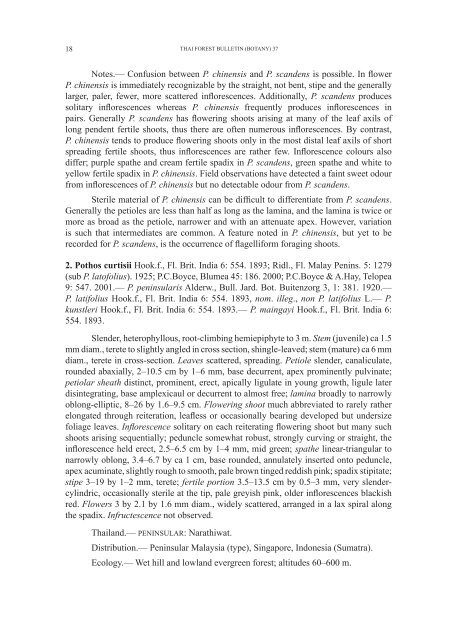You also want an ePaper? Increase the reach of your titles
YUMPU automatically turns print PDFs into web optimized ePapers that Google loves.
18<br />
<strong>THAI</strong> <strong>FOREST</strong> <strong>BULLETIN</strong> (BOTANY) 37<br />
Notes.— Confusion between P. chinensis and P. scandens is possible. In flower<br />
P. chinensis is immediately recognizable by the straight, not bent, stipe and the generally<br />
larger, paler, fewer, more scattered inflorescences. Additionally, P. scandens produces<br />
solitary inflorescences whereas P. chinensis frequently produces inflorescences in<br />
pairs. Generally P. scandens has flowering shoots arising at many of the leaf axils of<br />
long pendent fertile shoots, thus there are often numerous inflorescences. By contrast,<br />
P. chinensis tends to produce flowering shoots only in the most distal leaf axils of short<br />
spreading fertile shoots, thus inflorescences are rather few. Inflorescence colours also<br />
differ; purple spathe and cream fertile spadix in P. scandens, green spathe and white to<br />
yellow fertile spadix in P. chinensis. Field observations have detected a faint sweet odour<br />
from inflorescences of P. chinensis but no detectable odour from P. scandens.<br />
Sterile material of P. chinensis can be difficult to differentiate from P. scandens.<br />
Generally the petioles are less than half as long as the lamina, and the lamina is twice or<br />
more as broad as the petiole, narrower and with an attenuate apex. However, variation<br />
is such that intermediates are common. A feature noted in P. chinensis, but yet to be<br />
recorded for P. scandens, is the occurrence of flagelliform foraging shoots.<br />
2. Pothos curtisii Hook.f., Fl. Brit. India 6: 554. 1893; Ridl., Fl. Malay Penins. 5: 1279<br />
(sub P. latofolius). 1925; P.C.Boyce, Blumea 45: 186. 2000; P.C.Boyce & A.Hay, Telopea<br />
9: 547. 2001.— P. peninsularis Alderw., Bull. Jard. Bot. Buitenzorg 3, 1: 381. 1920.—<br />
P. latifolius Hook.f., Fl. Brit. India 6: 554. 1893, nom. illeg., non P. latifolius L.— P.<br />
kunstleri Hook.f., Fl. Brit. India 6: 554. 1893.— P. maingayi Hook.f., Fl. Brit. India 6:<br />
554. 1893.<br />
Slender, heterophyllous, root-climbing hemiepiphyte to 3 m. Stem (juvenile) ca 1.5<br />
mm diam., terete to slightly angled in cross section, shingle-leaved; stem (mature) ca 6 mm<br />
diam., terete in cross-section. Leaves scattered, spreading. Petiole slender, canaliculate,<br />
rounded abaxially, 2–10.5 cm by 1–6 mm, base decurrent, apex prominently pulvinate;<br />
petiolar sheath distinct, prominent, erect, apically ligulate in young growth, ligule later<br />
disintegrating, base amplexicaul or decurrent to almost free; lamina broadly to narrowly<br />
oblong-elliptic, 8–26 by 1.6–9.5 cm. Flowering shoot much abbreviated to rarely rather<br />
elongated through reiteration, leafless or occasionally bearing developed but undersize<br />
foliage leaves. Inflorescence solitary on each reiterating flowering shoot but many such<br />
shoots arising sequentially; peduncle somewhat robust, strongly curving or straight, the<br />
inflorescence held erect, 2.5–6.5 cm by 1–4 mm, mid green; spathe linear-triangular to<br />
narrowly oblong, 3.4–6.7 by ca 1 cm, base rounded, annulately inserted onto peduncle,<br />
apex acuminate, slightly rough to smooth, pale brown tinged reddish pink; spadix stipitate;<br />
stipe 3–19 by 1–2 mm, terete; fertile portion 3.5–13.5 cm by 0.5–3 mm, very slendercylindric,<br />
occasionally sterile at the tip, pale greyish pink, older inflorescences blackish<br />
red. Flowers 3 by 2.1 by 1.6 mm diam., widely scattered, arranged in a lax spiral along<br />
the spadix. Infructescence not observed.<br />
Thailand.— PENINSULAR: Narathiwat.<br />
Distribution.— Peninsular Malaysia (type), Singapore, Indonesia (Sumatra).<br />
Ecology.— Wet hill and lowland evergreen forest; altitudes 60–600 m.
















